![]()
|
Index | Pottery | Pottery manufacturers Wood & Brownfield |
| [Robinson
& Wood] 1832-6 |
[Robinson,
Wood & Brownfield] 1836-41 |
[Wood &
Brownfield] 1841-50 |
[William
Brownfield & Son/s] 1850-91 |
[Brownfields
Guild Pottery Society] 1891-98 |
[Brownfields
Pottery Ltd] 1898-9 |
Location and period of operation:
|
Wood &
Brownfield |
Cobridge |
March
1841 |
1850 |
|
Manufacturers of earthenware and ironstone at Cobridge, Stoke-on-Trent, England Wood &
Brownfield was a short-lived but influential pottery partnership that
became the foundation for the highly successful William Brownfield &
Son pottery. The company is noted for producing high-quality ceramics,
which were highly regarded during the mid-to-late 19th century.
|
Formerly: Robinson, Wood & Brownfield
Subsequently: W. Brownfield
testimony of the workers
|
Samuel
Scriven interviewed employees from Stoke-on-Trent pottery works for the
Royal Commission on Children’s Employment in 1841. Some of the evidence
taken at Messrs Wood and Brownfield’s works — is reproduced below. "These premises are extensive, rooms better than common" February
11th. (1841)
|
|
Messrs.
WOOD and BROWNFIELD's Earthenware Factory, Cobridge. |
|
|
No. 208.- Sarah Morris |
aged 28 |
|
No. 208.- Ann Bradbury |
aged 35 |
|
We are the superintendents of the apprentice girl’s painting department, and have 24 females of all ages in the same room ; out of that number there are 10 children under 13 years of age. Most of them can read, but few write. They come at seven in the morning, and leave at six; they - are allowed half an hour for breakfast one hour for dinner. Some that live away off stay to get their dinners in the work-rooms ; they cook them on the stove-pots; ; always take their hour, and sometimes play before they begin work. Some live pretty well,—others but middling. Their general conduct is tolerably good. We keep our eyes upon them, and check anything like misconduct. They get their regular holidays at wake times. We have no other rewards except that of putting them forward in their trade. Have no punishments by making them paint extra pieces, because they do piece-work, and all try to do as much as they can. They get
here half the price of journeywomen for the first five years. We think that
taking an equal number of girls from the painting-room and from other
occupations in the same sphere of life, in point of moral conduct the painters
would prove superior. |
|
|
Messrs.
WOOD and BROWNFIELD's Earthenware Factory, Cobridge. |
|
|
No. 209.- Robert Humphries |
aged 8 |
|
I turn jigger for William Massey. Have been to work about six months. Can read a little, not much—cannot write. Went to Catholic day school ; go now to Sunday school ; go to the Methodist Chapel every Sunday. My father has been dead four years. My mother lives at home ; her does nothing. I have a brother six years old ; he goes to school. I get 10 1/2d. a week ; only work three days a week. I get for breakfast milk-meat and dry bread ; gravy and tatees
for dinner, - sometimes onions. I come at hafe-past six ; go home at hafe-past
six ; get my supper, and go to bed very tired. |
|
|
Many of Wood & Brownfield's ironstone china patterns are a classic examples of the Chinoiserie style, which was highly popular in 19th-century European ceramics and draws inspiration from East Asian art and motifs. The patterns often feature intricate Oriental-style landscape, commonly depicting elements like a prominent pagoda or temple-like building, a picturesque bridge, and serene water. Quintessential Chinoiserie motifs are included, such as stylised trees with elegant, sprawling branches, possibly willow trees or other blossoming flora, and often includes delicate figures in traditional attire and birds in flight or perched amongst the foliage. |
|
source acknowledgement: online marketplace Etsy.co.uk
|
printed mark featuring the British Royal Arms
|
|
source acknowledgement: limassol.castle_auctions.com |
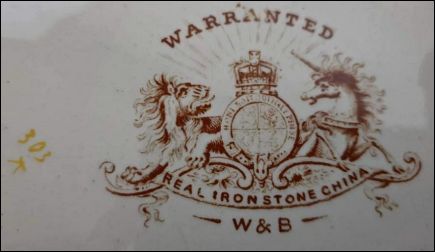
Warranted Real Ironstone China W & B
these
marks are used on various items in the |
|
source acknowledgement: online marketplace - ebay.co.uk |
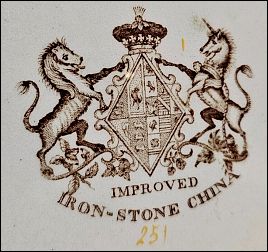 Improved Iron-Stone China
|
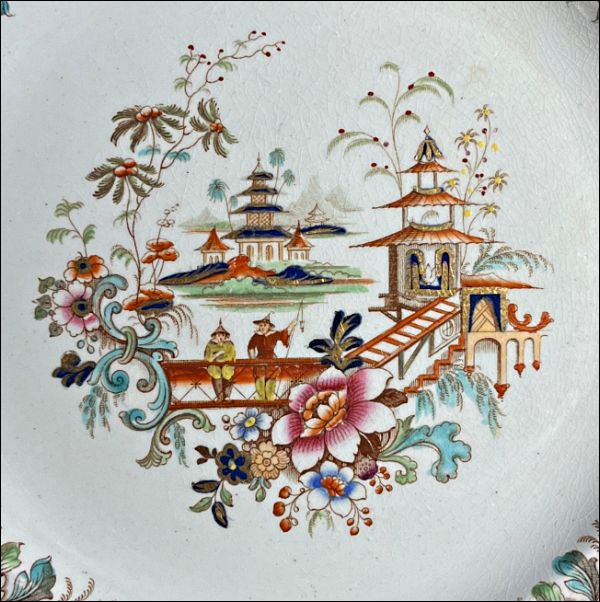 detail of pattern 335
photos courtesy: Laurie Ward |
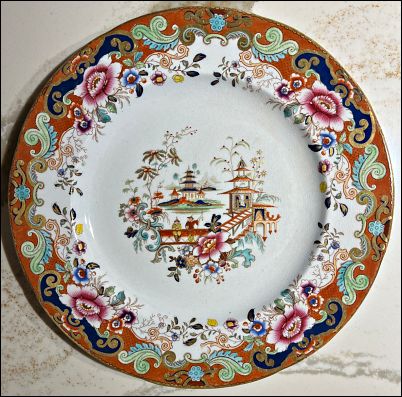
|
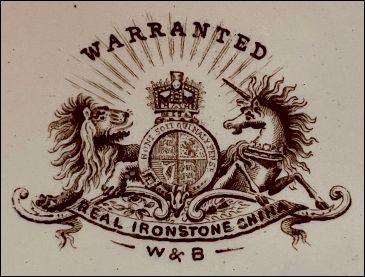
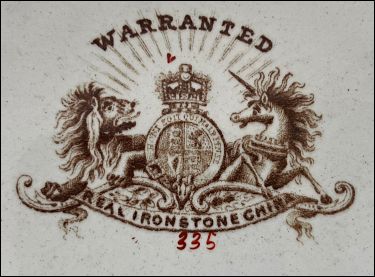
These marks incorporating the British Royal Arms appear on various pieces in the dinner ware
Note
the slight variation in that the initials 'W&B' are not included on all
marks and
the painted pattern number does not appear on all pieces - this is unusual but
not uncommon
Wood & Brownfield patterns and marks
|
Some patterns, and the style of marks, were introduced by Robinson, Wood & Brownfield and then continued by Wood & Brownfield and subsequently by William Brownfield (& Sons/s). They were known for producing elaborate Chinoiserie style patterns - printed with hand-colouring (coloured over-print), enamel over glazes, and gilding in decorative borders. Also they produced transferware patterns, generally for more everyday use.
The successor company William Brownfield was known for the production of relief moulded jugs. However Wood & Brownfield are known to have produced at least two designs of relied moulded jugs which carry the impressed mark "Published by Wood & Brownfield, Cobridge, Staffordshire Potteries, January 1st 1841" - the other date is "30th September 1841" (Henrywood - retrieved 28 Sept 2025) |
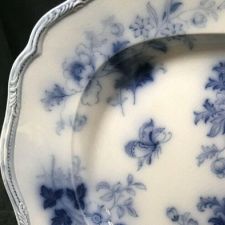 |
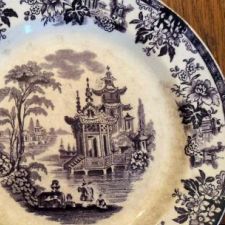 |
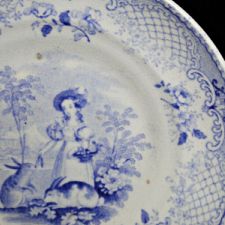 |
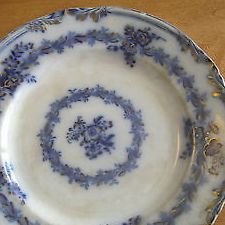 |
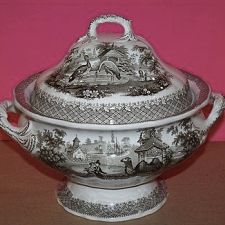 |
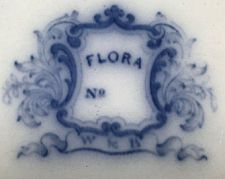 |
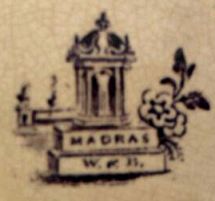 |
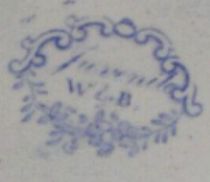 |
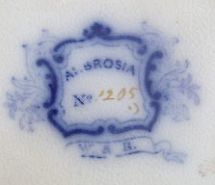 |
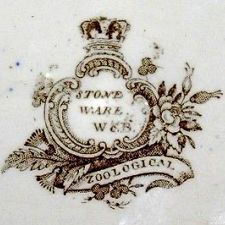 |
source acknowledgement: worthpoint.com
NOTE: Wood & Brownfield marks carry the initials "W & B"
marks with "WB" are those of the successor company William Brownfield
Questions, comments, contributions? email: Steve Birks
|
Page created 15 December 2001 i Scriven testimonies included. Updated: 28 Sep 2025 - introduction expanded, examples of ware and marks added. Updated: 5 Oct 2025 - examples of pattern 335 added |